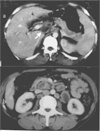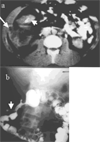CT features in abdominal tuberculosis: 20 years experience
- PMID: 12427257
- PMCID: PMC139990
- DOI: 10.1186/1471-2342-2-3
CT features in abdominal tuberculosis: 20 years experience
Abstract
BACKGROUND: Abdominal tuberculosis (TB) is endemic in the developing world and is reemerging in the West. Since computed tomography (CT) has the ability to demonstrate changes in the peritonium, mesentry, lymphnodes, bowel and solid organs and is being increasingly used for primary evaluation of abdominal conditions, it is important to be familiar with the CT features of the disease. METHODS: CT findings were retrospectively analysed in 49 patients with proved abdominal TB. Patients with genitourinary TB and with AIDS/HIV were not included in the study. RESULTS: Peritoneal involvement was the most common feature (77.5%) with ascites (wet peritonitis) seen in more than half the cases (55.2%). The rest showed peritoneal, mesenteric or omental thickening or mass formation but no ascites (dry peritonitis). Other findings included lymphadenopathy (46.9% mainly of diffuse nature, bowel wall thickening (38%) and solid organ involvement (20.4%). CONCLUSIONS: CT reliably demonstrates the entire range of findings which need interpretation in the light of clinical and laboratory data.
Figures









References
LinkOut - more resources
Full Text Sources

